인문사회 21
약어 : 인문사회 21
2022, vol.13, no.2, 통권 51호 pp. 2563-2576 (14 pages)
발행기관 : 인문사회 21
연구분야 : 사회과학 > 기타사회과학
초록
이 연구의 목적은 서세동점의 근대 시기 조선에서 사회 변혁적 공공의식의 두 분화를 엘리트 지식인 집단인 개화파와 민중이 중심이 된 동학공동체로 나누고 이 둘의 공통되는 특징과 차이점을 고찰하는 것이다. 연구방법은 19세기 후반 대내외에서 요청하는 시대 변혁 요구에 대한 응답으로 공공에 대한 이해와 의식의 지점을 살피고 개화파와 동학공동체 각각의 공공의식의 특징을 규정할 것이다. 이 연구의 결과는 다음과 같다. 개화파는 부국강병과 국민 통합을 목적하는 공공의식을 우선하였다. 동학공동체는 인간의 자각적인 평등을 강조하고 민중의 자생적인 공동체를 지향하는 공공의식을 지향한다. 이 논의는 19세기 조선에서 추구한 근대의 성격이 어떠했는지의 규명에 도움이 될 것이다.
The purpose of this study is to examine the common characteristics and differences of the two, divided into the elite intellectual group Gaehwa-Pa and the people-centered Donghak community in Joseon in a time of Western powers advancing toward East Asia (西勢東漸). The research method will examine the point of understanding and consciousness of the public in response to the demands for change of the times, both internally and externally in the late 19th century, and define the characteristics of the public consciousness of each of Gaehwa-Pa and Donghak communities. The results of this study are as follows. The Gaehwa-Pa prioritized public consciousness aimed at strengthening the rich nation and integrating the people. The Donghak community emphasizes the self-conscious equality of human beings and aims for a public consciousness that aims for a self-sustaining community of the people. This discussion will be helpful to find out what the modern characteristics pursued in the 19th century were like.

